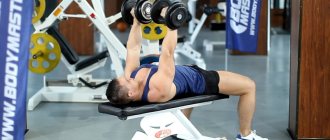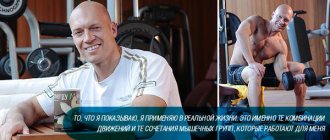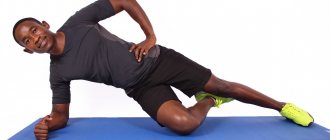Training twice a day is real! And they can be very different. They can be used for weight, strength and weight loss. And there is nothing unusual about this! But training twice a day requires appropriate organization of rest. Because training twice a day and recovering incorrectly is pointless! All this can lead to is muscle pain . And there is nothing good about it. It only slows down progress. Because progress in results is ensured by progression of loads. Which is simply impossible in the case when the muscles have not yet reached the moment of supercompensation . And it will come later, the less adequate the load is to your level of training.
Another important element of training twice a day is the recovery process. Namely, diet and sleep-wake patterns. Therefore, it is recommended that you familiarize yourself with the weight loss diet or weight loss diet . For women - with a diet for fit-necks . Read about organizing a proper sleep schedule in our article on its benefits. BUT! It is important to understand that you cannot work hard all day between workouts, drink alcohol, or otherwise interfere with recovery. More precisely, you can, of course, work in an office. You can take a walk. You can meet a girl or a guy. But all this needs to be adjusted to suit your feelings and cut back if you feel under-recovered for the next workout.
Strength training twice a day
Day #1
Morning Barbell squats - 5 sets of 5 reps Romanian deadlifts - 4 sets of 6 reps Lying leg curls - 4 sets of 8 reps Exercise bike - 40 minutes
Evening Bent-over barbell rows - 6 sets of 6 reps Seated dumbbell swings - 4 sets of 8 reps Bench press - 6 sets of 6 reps Arm extensions on a block - 4 sets of 8 reps
Day #2
Morning Classic deadlift - 6 sets of 6 reps Hyperextension - 4 sets of 8 reps Exercise bike - 40 minutes
Evening Front squats - 4 sets of 8 reps Seated leg extensions - 4 sets of 8 reps Angled barbell press - 4 sets of 6 reps Lat rows - 4 sets of 6 reps
Day #3
Morning Romanian deadlift - 4 sets of 8 reps Donkey - 4 sets of 8 reps Hyperextension - 4 sets of 10 reps Exercise bike - 40 minutes
Evening T-bar rows - 4 sets of 8 reps Biceps curls - 6 sets of 6 reps Dumbbell swings - 4 sets of 8 reps
Notes* rest in basic exercises 2-3 minutes, in auxiliary exercises 1-2 minutes; you can train every day; duration of the scheme is 1 month; The scheme can be used both for targeted development of strength indicators and as a developmental cycle of a weight program; It is recommended to take creatine . Be sure to use a diet for weight!
Is it safe to exercise twice a day?
zaragala, 07/05/2013 from 2 Comments
For the effectiveness of training and to achieve your goals, the intensity of the training is important, not its duration
Last spring, I packed my bags, grabbed my yoga mat, and flew to Australia. Six months later, I flew back home to find that I had gained almost ten pounds. In Australia, I ran in the mornings, swam a lot in the pool, and regularly did yoga at sunset, sitting on a rock overlooking the beach (a little jealous?). But despite this, within a few months my weight increased due to alcohol and night drinking. Upon returning home, I came up with a weight loss plan: I decided to workout twice a day. But is it safe to exercise twice a day? We spoke to experts to find out if working out twice a day is good for your health?
My goal was to lose weight, but that's not the only reason people go to the gym twice a day. Some people want to build muscle, others need to train intensely for a competition. Research shows that regular exercise and fitness activities are essential for maintaining a healthy lifestyle, maintaining an optimal weight and maintaining a healthy heart. For some people, one workout a day is not enough to achieve these goals.
Many studies have been conducted to compare the effects on human health of one workout lasting 1 hour and two workouts - each lasting 30 minutes. It turned out that for the effectiveness of training and for achieving your goals, the intensity of the training is important, not its duration. During intense physical exercise, our body reacts sensitively to the training and we get results. An adult needs at least 150 minutes of moderate aerobic activity per week (this could be walking or swimming) or 75 minutes of vigorous aerobic activity per week (such as running or vigorous aerobics).
The number of workouts per day should depend on your goals. If training is carried out to prepare athletes for competitions, or in order to quickly achieve results, then intensive training can be used several times a day. But if you are training to stay active and in good physical shape, then you do not need heavy, frequent training - it is more advisable to choose an easy training regimen. However, if you plan to train more than once a day then you need to follow some rules:
1. Find a balance To avoid overtraining, you need to balance between high and low intensity workouts. It is necessary to gradually increase the intensity, duration and frequency of training - taking small steps will help prevent injury and allow the body to recover. Most people should avoid two consecutive intense workouts in the same day, such as running and cycling. Otherwise, with an average level of physical fitness, overtraining syndrome may occur.
2. Intervals between workouts It is necessary to ensure a sufficiently large time interval between workouts (experts suggest that the optimal interval is 6 hours). If the effectiveness of your workouts begins to decrease from workout to workout, then you probably need to rest for a few days.
3. Nutrition It is very important to use protein nutrition before and after training. And don't forget about water! A glass of water is as important as a protein shake. Insufficient water intake during exercise can be harmful to your health.
4. Sleep Research shows that lack of sleep and poor sleep quality can damage and interfere with the effectiveness of your workouts. Therefore, for good health it is very important to ensure healthy, long sleep.
5. Duration of training On average, it is advisable to train 60-90 minutes a day; you can split the training into two parts - 30-45 minutes each. To avoid signs of overtraining, it is important to maintain a balance, not to give too much load at once, and to monitor the body's reaction. Once a week you definitely need to take a day off! Take a break, relax. This doesn't mean you need to lie on the couch all day - you can walk the dog, do everyday chores around the house. This will help the body recover and prepare for the next training cycle.
We recommend: Gadgets for training in the Medgadgets catalog
Tags intense training, number of training sessions, training effectiveness
Workout twice a day for mass and cutting
Morning Leg press - 4 sets of 15 reps Seated leg extensions - 3 sets of 15 reps Lying leg curls - 4 sets of 15 reps Bench press - 3 sets of 12 reps Lat rows - 3 sets of 12 reps Exercise bike - 15 minutes for mass and 40 minutes to dry
Evening Romanian deadlift - 4 sets of 12 reps Hyperextension - 3 sets of 15 reps Angled barbell press - 3 sets of 12 reps Cable arm extensions - 3 sets of 12 reps Lower block row - 3 sets of 12 reps Seated dumbbell swings - 3 set of 12 repetitions Exercise bike - 15 minutes for mass and 40 minutes for drying
Notes* rest 30‒60 seconds; you need to train daily; duration of the regimen is 1–2 months for weight, 1–3 months for weight loss; When gaining weight, you should use a weight-loss diet, and when losing weight, use a weight-loss diet. It is not necessary to take sports nutrition, but you can use the scheme outlined in the article about the anabolic window .
Training programs
Training twice a day. "Pros and cons".
Doing two workouts a day is quite a challenge, but proper use of this training element will teach you to run on “tired legs.”
Of course, in the world of professional athletes, two workouts a day is hardly such a rarity, but for an amateur it still looks a little like a craving for masochism. However, training twice a day has its physiological and psychological benefits.
Running on tired legs
Towards the end of the race, we feel exhausted and tired, but our task is to find our hidden reserves and finish with dignity (or even take a podium place). If we learn to find this strength within ourselves during training and motivate ourselves to run, despite fatigue, this will be an additional advantage when the day of the competition comes.
By doing a workout early in the morning and returning to it in the evening, you will no doubt feel doubly tired. But what's interesting is that the more often runners who practice this type of training do it, the better they begin to feel in the second workout after they warm up and start running. The second training, as it were, “polishes” the first.
The second workout is usually aimed at speed and strength. Just as at the end of a race you gather all your will into a fist, so the second training teaches you to cope with fatigue and fight to the end. The good news is that after you go through a period of hardship, your body and mind will adapt to the repeated challenge and you will feel better.
Psychological stability
There is another important component of hard training twice a day - mental. Thanks to the fact that you have already learned to perfectly navigate yourself during the difficult second training, you know that you can “add” to the end of the race, although the strength seems to be running out, and the body can make an effort, although the mind is trying to do so prevent.
For marathon runners doing two workouts a day, a good solution that will lighten the load a little is to cover a lot of mileage in two workouts instead of doing it in one. Moreover, if you have a completely free day (without work or any tasks), then why don’t you spend it on two full workouts? 
Specifics (training method)
Brad Hudson, author of “Run Faster From the 5K to the Marathon,” says he often uses heavy double workouts during an “easy” block of training. The second workout involves short 200m repeats on the stadium or 200-300m uphill sections. He believes that speed segments are a great addition to a normal workout. But if we are talking about a “heavy” block, then it will look like this:
In the morning: warm-up 5km, work: 3x5km with 1 minute rest and 5km cool-down.
In the evening: warm-up – 5 km, 4x400/600m speed repeat/recovery, 2 km – cool-down.
Rest between workouts – 8 hours.
If your goal is to increase your running performance:
Morning: tempo run
In the evening: 200m repeats with full recovery or mountain “explosive” segments to strengthen and increase strength and speed endurance
Heavy training block:
Morning: 4x2km
Evening: 4-5x600 meters
Methodology for marathon runners
Hudson agrees with coach Renato Canova on the use of double training for sprinters and long-distance runners, but their views differ when it comes to marathon runners: “I don’t use them in a marathon training plan, like 2 workouts for 20 km, as I believe that they are too physically and psychologically exhausting. Although Canova thinks differently.”
Canova training
Morning: 10km (pace 5:40-5:30)+ 10km (5.10-5.00)*
Evening: 10km (5:30-5:25) + 10x1km (2:55 with 1.5 minute recovery break)* *Pace is based on elite runners so should not be attempted.
Recovery
We always want to train as much as possible, but we need to try not to overdo it. Double workouts do not need to be repeated twice every week. It is enough to carry them out once every 2-4 weeks and allow sufficient time for recovery. And remember that speed segments in the second workout are good, but after such days you need to give your body a rest for at least two days.
Periodization in preparation for the half marathon and 10 km according to the Hudson system
- Morning: 6 km uphill run. Evening: 8x200m;
- Morning: 7.5 km uphill run. Evening: 10x200m;
- 2x5 km/60 sec recovery. Evening: 8x300m;
- Strength block
Morning: 12 km tempo run. Evening: 8x1.5km speed run; - Aerobic
Morning: 8km (half marathon pace). Evening: 8km (half marathon pace). - Late season
Morning: 4x2km. Evening: 4x400m acceleration. - Morning: 5km tempo run. Evening: 1600m+8x400m.
Afterword
By training your endurance and getting used to training when you're tired, you'll be more prepared to push hard at the end of the race. Double training may not always seem attractive, but the rewards will not be long in coming.
Author: Alexander Kostyushko
Benefits of Exercising Twice a Day
Many strength coaches have touted the benefits of training twice a day, and numerous strength athletes train multiple times a day. Canadian trainer Charles Poliquin even suggested that muscles will grow better if you train twice a day on a regular basis.
Obviously, this is not feasible for everyone who works out in a gym for many reasons, but everyone can benefit from using this type of training program from time to time.
One of the greatest benefits of this program is the obvious actual action: working the same muscle group twice in one day.
For those of you who have experienced strength gains and muscle growth from adding science-backed post-workout meals and supplements to your diet, you will automatically see the benefits of eating twice in one day post-workout.
By training twice a day, you get protein synthesis and other anabolic benefits, and if you take full advantage of this by having two meals and supplements post-workout, you can see how quickly you gain muscle mass.
You will also be able to train with greater intensity. When faced with a full hour-long workout, most of us subconsciously conserve energy early in the session to make it through to the end.
If we don't do this, the last part of the training may come to nothing. By dividing the total work between two workouts, you can train with greater overall intensity. Since intensity is the key to increasing strength and muscle growth, this also has its obvious benefits.
Finally, something for those of you who are trying to get rid of a few kilos of unsightly fat reserves; It has been proven many times, both in the laboratory and in the real world, that when you split your workout into two separate sessions on the same day, you burn more total calories than if the entire workout was done in the same day. time.
This means that a larger calorie deficit is created, and when you combine this with the muscle growth that can be achieved quickly with this training approach, you begin to realize that the twice-a-day program is ideal for rapid fat loss.
Read also: 2 simple ways to keep your body symmetrically developed.
How to pump up in one session a week?
Multi-joint exercises required
. Deadlifts, lunges and squats are great.
In one session you should pay attention to the whole body
. Only one exercise should be performed for each muscle group. 2-3 sets of 6-12 repetitions are recommended. If you exercise several times, then it would be more advisable to pump different muscle groups separately.
Photo: istockphoto.com
Don't skip the warm-up
. Before training, it is advisable to warm up the body for 10-15 minutes. This way you will warm up your muscles, prepare for exercise and reduce the risk of injury.
Doesn't size matter? Why you shouldn’t compare muscle volume and strength
Training plan
The possible programs you can develop using the twice a day concept are literally endless, let's look at one of them.
There are several options for changing the intensity between two workouts, one of the most effective is to work with heavy weights in the first workout and lighter weights in the second.
This allows you to train your muscles with high intensity and low volume in the morning and do a lower intensity, higher volume workout in the evening. Volume is also important when you are trying to achieve additional muscle growth.
Read also: Full Body style training program for beginners.
5 day split
- Day 1: Chest/Back
- Day 2: legs
- Day 3: rest
- Day 4: Shoulders/Arms
- Day 5: rest
Day 1: Chest and Back
MORNING
- Push-ups on parallel bars with an emphasis on the chest with extra. weights - 6 sets of 2-5 repetitions.
- Pull-ups on the horizontal bar with additional weights - 6 sets of 2-5 repetitions.
EVENING
- Dumbbell bench press on an incline bench - 2 sets of 10-15 repetitions.
- Bent-over barbell rows - 2 sets, 10-15 reps.
- Pull-ups on the horizontal bar with additional weights – 6 sets of 2-5 repetitions.
- Incline dumbbell raises - 2 sets, 10-15 reps.
Day 2: Legs
MORNING
- Back squats - 6 sets, 2-5 reps.
- Romanian barbell row - 3 sets of 2-5 reps.
- Seated calf raises - 3 sets of 3 reps.
EVENING
- Front squats with a barbell – 4 sets of 10-15 reps.
- Leg curls in the simulator - 4 sets of 10-15 repetitions.
- Leg press – 2 sets of 10-15 reps.
- Bent-downs with a barbell “Good morning” - 2 sets of 10-15 repetitions.
- Standing calf raises in the simulator - 3 sets of 15-20 repetitions.
Day 3: Rest
Day 4: Shoulders and Arms
MORNING
- Military press – 6 sets of 2-5 reps.
- Barbell curls for biceps – 3 sets of 2-5 reps.
EVENING
- Barbell curls on a Scott bench - 2 sets of 10-15 reps.
- French bench press - 2 sets of 10-15 reps.
- Seated overhead dumbbell press - 2 sets, 10-15 reps.
- Dumbbell lateral raises - 2 sets of 10-15 reps.
- Raises of arms with dumbbells lying chest on an inclined bench - 2 sets, 10-15 repetitions.
Day 5: Rest
Note. This five-day split fits into a two-week interval if the fifth day is a day off. Thus, the last training day (shoulders/arms) of the third rotation would be on day fourteen, or three 5-day splits in exactly two weeks.











